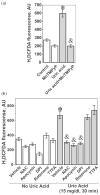Uric acid: the oxidant-antioxidant paradox
- PMID: 18600514
- PMCID: PMC2895915
- DOI: 10.1080/15257770802138558
Uric acid: the oxidant-antioxidant paradox
Abstract
Uric acid, despite being a major antioxidant in the human plasma, both correlates and predicts development of obesity, hypertension, and cardiovascular disease, conditions associated with oxidative stress. While one explanation for this paradox could be that a rise in uric acid represents an attempted protective response by the host, we review the evidence that uric acid may function either as an antioxidant (primarily in plasma) or pro-oxidant (primarily within the cell). We suggest that it is the pro-oxidative effects of uric acid that occur in cardiovascular disease and may have a contributory role in the pathogenesis of these conditions.
Conflict of interest statement
Conflict of Interest: Dr. Johnson has patent applications related to the lowering of uric acid as a means for treating cardiovascular disease and obesity via the University of Florida and University of Washington.
Figures





References
-
- Wu XW, Muzny DM, Lee CC, Caskey CT. Two independent mutational events in the loss of urate oxidase during hominoid evolution. J Mol Evol. 1992;34:78–84. - PubMed
-
- Oda M, Satta Y, Takenaka O, Takahata N. Loss of urate oxidase activity in hominoids and its evolutionary implications. Mol Biol Evol. 2002;19:640–653. - PubMed
-
- Johnson RJ, Kang DH, Cade JR, Rideout BA, Oliver WJ. Uric acid, evolution and primitive cultures. In: Uric acid in Cardiovascular and Renal Disease. Semin Nephrol. 2005;25:3–8. - PubMed
-
- Alper AB, Jr, Chen W, Yau L, Srinivasan SR, Berenson GS, Hamm LL. Childhood uric acid predicts adult blood pressure: the Bogalusa Heart Study. Hypertension. 2005;45:34–38. - PubMed
Publication types
MeSH terms
Substances
Grants and funding
LinkOut - more resources
Full Text Sources
Other Literature Sources
Medical
